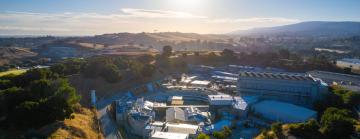Ion swap dramatically improves performance of CO2-defeating catalyst
Supported by SLAC's catalysis group Co-ACCESS, researchers discover new ways to boost the performance of catalysts that turn carbon dioxide into methanol.
A team of researchers led by the Department of Energy’s Oak Ridge National Laboratory (ORNL), with support from the Stanford Synchrotron Radiation Lightsource (SSRL) at DOE's SLAC National Accelerator Laboratory, found a better way to convert carbon dioxide to methanol, tripling the amount of methanol produced as compared to current techniques.
That feat was made possible through a subtle and novel addition to a standard catalyst, a substance that speeds a chemical reaction while itself remaining unchanged. The new approach, the researchers say, demonstrates a novel pathway to designing catalysts for the purpose of converting carbon dioxide to methanol.
Normally, a catalyst uses a support to stabilize nanometer-sized metal particles, or metal nanoparticles. The interaction between the nanoparticles and their support also creates a unique interface that can dramatically enhance the reaction rate, as well as the ability to direct the reaction to yield a specific product.
In the case of catalysts designed to convert carbon dioxide into methanol, one approach is to sprinkle copper nanoparticles on a support made of barium titanate, a kind of perovskite. Previous work has investigated the effect of introducing positively charged ions, or cations, into that support to see what improvements could be made.
In the new study, the ORNL team and their colleagues put a twist on previous efforts, focusing on understanding and controlling the effect of negatively charged ions, or anions, in the support. When the researchers partially replaced oxygen anions from the support with hydrogen anions, that swap altered the reaction and tripled the yield of methanol.
“Tuning the anion site of the catalyst support can greatly impact the metal-support interface, which leads to enhanced conversion of waste carbon dioxide to valuable fuels and other chemicals,” said project head Zili Wu, leader of ORNL’s Surface Chemistry & Catalysis Group.
SLAC researchers helped make those discoveries possible. Although the chemical reaction involved has been studied for decades, what happens during the reaction has remained more mysterious, in part because probing the catalyst under different conditions took expertise and equipment that are hard to find outside national labs.
To reveal the structure of the catalyst under working conditions, ORNL researcher Yuanyuan Li and former postdoctoral fellow Yang He collaborated with SSRL’s Staff Engineer Jorge Perez-Aguilar and Distinguished Scientist Simon R. Bare. Through the Consortium for Operando and Advanced Catalyst Characterization via Electronic Spectroscopy and Structure (Co-ACCESS) at SSRL, they used in situ X-ray absorption spectroscopy to reveal the structure of the copper nanoparticles under high-pressure reaction conditions.
“I'm really proud that we pulled from diverse teams to illuminate the underlying mechanism,” Wu said.
The research findings, published in Angewandte Chemie International Edition, point to a unique role that hydrogen anions, or hydrides, could play in boosting the performance of catalysts that turn carbon dioxide into methanol. Wu’s team was the first to use anion substitution to this end. Such catalysts could join the portfolio of technologies aimed at achieving global net-zero carbon dioxide emissions by 2050.
“This research is the latest outcome of the successful collaboration between the catalysis group at ORNL and Co-ACCESS at SSRL,” Bare said, adding that SSRL is one of the best places to conduct studies that require high-pressure gasses and strict safety protocols. “The expertise and dedication of our staff enable such complex experiments to be performed.”
Next, Wu and colleagues will change the reactivity of the hydride in the support by changing the perovskite’s composition. “This approach of anion tuning of catalysts provides a new paradigm for controlling chemical reactions,” Wu said.
Additional contributors to this paper include Miaofang Chi and Hwangsun “Sunny” Kim (ORNL), who performed scanning transmission electron microscopy; Yongqiang Cheng and Luke Daemen (ORNL), who conducted in situ high-pressure inelastic neutron scattering; Ming Lei with De-en Jiang (Vanderbilt University), who ran density functional theory calculations; and Yang He and Felipe Polo-Garzon (ORNL), who customized and performed steady-state isotopic transient kinetic analysis.
The DOE Office of Science supported the research. SSRL is a DOE Office of Science user facility.
This article is based on a press release from Oak Ridge National Laboratory.
Citation: Y. He et al., Angewandte Chemie, 31 October 2023, (https://doi.org/10.1002/anie.202313389).
Contact
For questions or comments, contact the SLAC Strategic Communications & External Affairs at communications@slac.stanford.edu.
About SLAC
SLAC National Accelerator Laboratory explores how the universe works at the biggest, smallest and fastest scales and invents powerful tools used by researchers around the globe. As world leaders in ultrafast science and bold explorers of the physics of the universe, we forge new ground in understanding our origins and building a healthier and more sustainable future. Our discovery and innovation help develop new materials and chemical processes and open unprecedented views of the cosmos and life’s most delicate machinery. Building on more than 60 years of visionary research, we help shape the future by advancing areas such as quantum technology, scientific computing and the development of next-generation accelerators.
SLAC is operated by Stanford University for the U.S. Department of Energy’s Office of Science. The Office of Science is the single largest supporter of basic research in the physical sciences in the United States and is working to address some of the most pressing challenges of our time.






